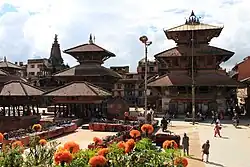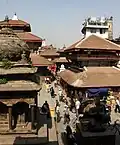Durbar Square

Durbar Square (from Persian دربار, darbār, meaning "court") refers to the public plazas located in front of the old royal palaces in Nepal, particularly in the Kathmandu Valley. These squares served as epicenters of political, religious, and social life during the Malla period (12th–18th centuries). The architecture of the squares reflects a rich blend of Hindu and Buddhist influences unique to Newar culture.
Each of the three main Durbar Squares—Kathmandu, Patan, and Bhaktapur—served as the royal seat of a separate Malla kingdom prior to the unification of Nepal under Prithvi Narayan Shah in the 18th century. These sites are renowned for their intricate wood carvings, multi-tiered temples, courtyards, and statuary, many of which date back several centuries.
Although the 2015 Gorkha earthquake caused significant damage to these sites, most structures have since been preserved or are under restoration, supported by both national and international efforts.[1][2]
Further reading
- von Schroeder, Ulrich. 2019. Nepalese Stone Sculptures. Volume One: Hindu; Volume Two: Buddhist. (Visual Dharma Publications). ISBN 978-3-033-06381-5. Contains SD card with 15,000 digital photographs of Nepalese sculptures and other subjects as public domain.
Gallery
-
 Maju Dega-Narayana-Shiva Parvati
Maju Dega-Narayana-Shiva Parvati -
 Pratapamalla-Jagannath
Pratapamalla-Jagannath -
 Bhimeshwara-Garuda
Bhimeshwara-Garuda -
 Maju Dega-Kamadev
Maju Dega-Kamadev -
_(cropped).jpg) Taleju
Taleju -
 Saraswati-Chyasin Dega
Saraswati-Chyasin Dega -

-
 Souvenirs
Souvenirs -
Bhagwati Temple (left), Big Bell or Taleju Bell, small Vishnu Temple (right), Kathmandu
-
.jpg) Patan Durbar Square
Patan Durbar Square -
.jpg) Patan Durbar Square
Patan Durbar Square
See also
References
- ^ Gutschow, Niels. The Nepalese Caitya: 1500 Years of Buddhist Votive Architecture in the Kathmandu Valley. Stuttgart: Edition Axel Menges, 1997. ISBN 9783930698801.
- ^ "Kathmandu Valley". UNESCO World Heritage Centre. Retrieved 6 August 2025.
 Media related to Durbar Square at Wikimedia Commons
Media related to Durbar Square at Wikimedia Commons
27°42′17″N 85°18′27″E / 27.70472°N 85.30750°E